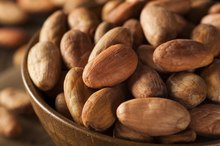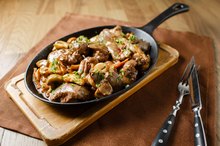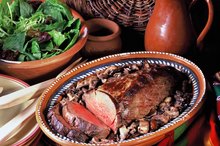Nutrition in Liver of Onions
Liver and onions, fried together in a pan, is a traditional health food so popular it was once lambasted in the comic strip, "The Far Side." Although liver and onions were thought healthy long enough ago that almost everything science believed about nutrition has changed, this meal still pulls its weight.
Serving Size and Calories
The USDA identifies a serving of liver and onions as one slice of liver with one slice of onion. This amounts to about 100 g of food per serving. Such a serving contains 156 calories. Of those calories, 28 come from carbohydrates, 93 from protein and 35 from fat.
- The USDA identifies a serving of liver and onions as one slice of liver with one slice of onion.
- Such a serving contains 156 calories.
Fat Profile
How to Cook Frozen Liver
Learn More
A 100-g serving of liver and onions contains 3.9 g of total fat. Unhealthy saturated fats make up 1.2 g of this, with heart-healthy unsaturated fats comprising the rest. ; 2006').
Carbohydrates
One serving of liver and onions carries 7.4 g of carbohydrates. These are evenly split between sugar carbohydrates and complex carbohydrates. Willett reports that complex carbs break down slowly, feeding your bloodstream a steady stream of energy for several hours. Sugar carbohydrates cause spikes and valleys in your blood sugar, which can stress your pancreas and lead to food cravings and weight gain.
- One serving of liver and onions carries 7.4 g of carbohydrates.
- Willett reports that complex carbs break down slowly, feeding your bloodstream a steady stream of energy for several hours.
Protein
Does Raw Cacao Cause Permanent Damage to the Liver?
Learn More
One serving of liver and onions delivers 25 g of protein, about 44 percent of your USDA recommended daily allowance. Since this protein comes from the liver, it's a complete protein. Like most animal proteins, it contains all the amino acids your body needs, but can't make for itself.
- One serving of liver and onions delivers 25 g of protein, about 44 percent of your USDA recommended daily allowance.
- Like most animal proteins, it contains all the amino acids your body needs, but can't make for itself.
Vitamins
Liver is incredibly rich in A and B vitamins. One serving of liver and onions contains well over your daily requirement for vitamins A, B2 and B12. It contains more than half your daily vitamins B3 and B6, along with smaller but substantial doses of vitamins B1, pantothenic acid and folate.
Minerals
A single serving of liver and onions contains nearly six times your daily required copper. It supplies between one-quarter and one-third of your daily iron, phosphorus, zinc and selenium. It also delivers smaller but significant amounts of magnesium and manganese. This comes at the cost of just 62 mg of sodium per serving, or about 3 percent of your daily limit.
- A single serving of liver and onions contains nearly six times your daily required copper.
Toxicity
The human liver processes toxins. ; 2006').
Related Articles
References
- "Baby 411"; Denise Fields and Ari Brown; 2009
- USDA: National Nutrient Database for Standard Reference 2009
- "Eat, Drink and Be Healthy"; Dr. Walter Willett, et al.; 2006
- Onions, raw. FoodData Central. U.S. Department of Agriculture. Published April 1, 2019.
- Anderson GH, Soeandy CD, Smith CE. White vegetables: Glycemia and satiety. Adv Nutr. 2013;4(3):356S-67S. doi:10.3945/an.112.003509
- Exploring aromatics. Academy of Nutrition and Dietetics. Updated 2020.
- Dabeek WM, Marra MV. Dietary quercetin and kaempferol: Bioavailability and potential cardiovascular-related bioactivity in humans. Nutrients. 2019;11(10). doi:10.3390/nu11102288
- Puccinelli MT, Stan SD. Dietary bioactive diallyl trisulfide in cancer prevention and treatment. Int J Mol Sci. 2017;18(8). doi:10.3390/ijms18081645
- Marrelli M, Amodeo V, Statti G, Conforti F. Biological properties and bioactive components of Allium cepa L.: Focus on potential benefits in the treatment of obesity and related comorbidities. Molecules. 2018;24(1). doi:10.3390/molecules24010119
- Chae MR, Kang SJ, Lee KP, et al. Onion (Allium cepa L.) peel extract (OPE) regulates human sperm motility via protein kinase C-mediated activation of the human voltage-gated proton channel. Andrology. 2017;5(5):979-989. doi:10.1111/andr.12406
- Smith AP, Sutherland D, Hewlett P. An investigation of the acute effects of oligofructose-enriched inulin on subjective wellbeing, mood and cognitive performance. Nutrients. 2015;7(11):8887-96. doi:10.3390/nu7115441
- Albanesi M, Pasculli C, Giliberti L, et al. Immunological characterization of onion (Allium cepa) allergy. Postepy Dermatol Alergol. 2019;36(1):98-103. doi:10.5114/ada.2019.82829
- Cooking with onions without crying. University of Nebraska-Lincoln. Updated 2020.
- What is the low FODMAP diet?. Academy of Nutrition and Dietetics. Updated 2019.
- Onions. RxList. Updated 2019.
- Shock CC, Cheatham NE, Harden JL, Mahony, AC, Shock BM. Types of onions and varieties. Oregon State University. College of Agricultural Sciences. Updated 2020.
- Dowdy S. Stored properly Vidalia onions can still be around this winter. University of Georgia. College of Agriculture and Environmental Science. Updated 2019.
Writer Bio
Jake Wayne has written professionally for more than 12 years, including assignments in business writing, national magazines and book-length projects. He has a psychology degree from the University of Oregon and black belts in three martial arts.









